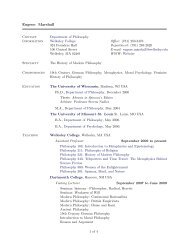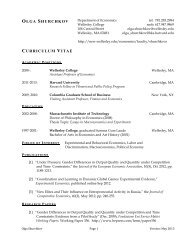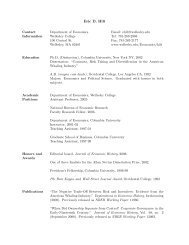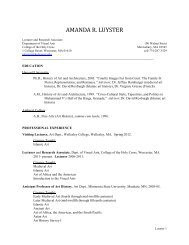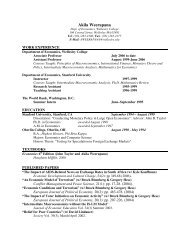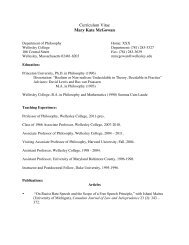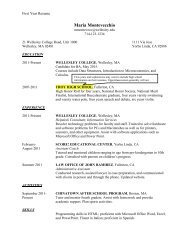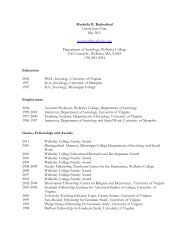PDF(575K) - Wiley Online Library
PDF(575K) - Wiley Online Library
PDF(575K) - Wiley Online Library
Create successful ePaper yourself
Turn your PDF publications into a flip-book with our unique Google optimized e-Paper software.
358 Ayub et al.<br />
Kempermann et al. (1997) investigated the effect of<br />
environmental enrichment on neurogenesis and neuronal<br />
progenitor cells in young mice (*postnatal day<br />
21). The enriched environment consisted of mice living<br />
communally in a large cage with a set of tunnels,<br />
running wheels, and toys to increase the complexity of<br />
living conditions; these environments were rearranged<br />
daily, to create novelty. The control environment<br />
included three mice living in a standard cage. After<br />
the 40-day environmental exposure, levels of BrdU<br />
incorporation in hippocampal cells were compared in<br />
short- and long-survival time studies, to determine differences<br />
in cell proliferation and survival, respectively.<br />
Contrary to the findings presented here, neuronal<br />
proliferation was unaffected by environmental<br />
enrichment, but cell survival (measured 4 weeks after<br />
BrdU administration) increased. However, in older<br />
mice long-term exposure (10 months) to enrichment<br />
did result in increased precursor proliferation and neuronal<br />
survival (Kempermann et al., 2002). Our results<br />
and those of Sandeman and Sandeman (2000) showing<br />
an influence of short-term environmental exposure on<br />
both proliferation and survival in crayfish may represent<br />
species differences in the regulation of neurogenesis<br />
by environment, or could be a reflection of the<br />
very distinct environments to which the crayfish were<br />
exposed. The control environment in the mouse studies<br />
was equivalent to standard group housing for mice.<br />
However, in the current series of experiments in crayfish,<br />
the deprived condition included space limitations<br />
that limited physical activity, social isolation and a<br />
barren landscape, replicating the conditions of the<br />
Sandeman and Sandeman (2000) study.<br />
Previous studies in mice and crustaceans have<br />
attempted to determine the individual contributions<br />
of the various environmental components to the<br />
regulation of neurogenesis. For example, voluntary<br />
physical activity and exercise have been shown to<br />
increase neurogenesis in mice as well as to reverse<br />
the decline in neurogenesis experienced by older animals<br />
(Van Praag et al., 1999; 2005). The enriched<br />
conditions used in the current studies provided a<br />
complex environment that included social interaction,<br />
a large space with interesting features such as plants<br />
and burrows, and the opportunity for exploration and<br />
physical activity. Our study did not clarify which of<br />
these elements may mediate the beneficial effects of<br />
enrichment. To establish the enriched and deprived<br />
conditions, however, several other environmental<br />
arrangements were tested. We found that the space<br />
limitations were a critical aspect of the deprived condition,<br />
and that use of a larger deprived environment<br />
eliminated the overall influence on proliferation,<br />
measured by BrdU incorporation, between the two<br />
Developmental Neurobiology<br />
groups of animals (data not shown). Space restrictions<br />
have been shown to inhibit animals’ growth<br />
(Rugh, 1934), and it is therefore possible that limitations<br />
in space and physical activity may be primary<br />
determinants of neurogenic potential in crayfish in<br />
these studies. Indeed, locomotory studies in large<br />
crayfish do show a weak correlation between the level<br />
of physical activity and the survival of adult-born<br />
neurons in large crayfish (CL > 25 mm), but no effect<br />
on proliferation (Sandeman, unpublished results).<br />
Locomotion therefore may be one critical element<br />
that differed between the two conditions in our study.<br />
Isolation versus social interaction did not appear to<br />
play a role in determining levels of neurogenesis in<br />
our study, as crayfish isolated in larger environments<br />
while developing the environmental conditions for<br />
these experiments did not have reduced levels of neurogenesis<br />
compared to those maintained in groups in<br />
the enriched environments (data not shown). Song et<br />
al. (2007) also studied the relationship between social<br />
interactions and neurogenesis in young adult crayfish,<br />
and found no effect of social dominance or social<br />
isolation on cell proliferation in Clusters 9 and 10,<br />
although social domination enhanced the survival of<br />
BrdU-labeled cells when compared to social subordination.<br />
Additional experiments are necessary to<br />
define which specific components of the enriched<br />
environment are crucial for the influences observed in<br />
the present study.<br />
Concomitant with the increase in BrdU incorporation<br />
into first-generation precursors in CL4 crayfish,<br />
there was a decrease in the total numbers of niche<br />
cells in the enriched animals compared with deprived;<br />
these data were acquired by counting the numbers of<br />
propidium iodide labeled nuclei in the niche. These<br />
findings are logical in the sense that an increased cell<br />
cycle rate among the niche precursors would result in<br />
more cells migrating away from the niche; this might<br />
result in fewer total numbers of niche precursors<br />
remaining in the niche. If the cell cycle rate slows, as<br />
in the deprived environment, niche precursors will be<br />
retained in the niche, causing their numbers to be<br />
larger relative to the enriched environment. Although<br />
these relationships are potentially interesting, this<br />
result was not replicated in the older CL10 crayfish,<br />
and so this effect may be specific to younger animals.<br />
Further, in CL10 animals, enrichment enhanced BrdU<br />
incorporation into the migratory second-generation<br />
neuronal precursors; a trend in this direction was also<br />
seen in CL4 crayfish, but this result was not statistically<br />
significant. Finally, our results confirm the influence<br />
of environment on BrdU incorporation among<br />
the third-generation precursors and their descendants<br />
in Clusters 9 and 10 previously reported by Sandeman



